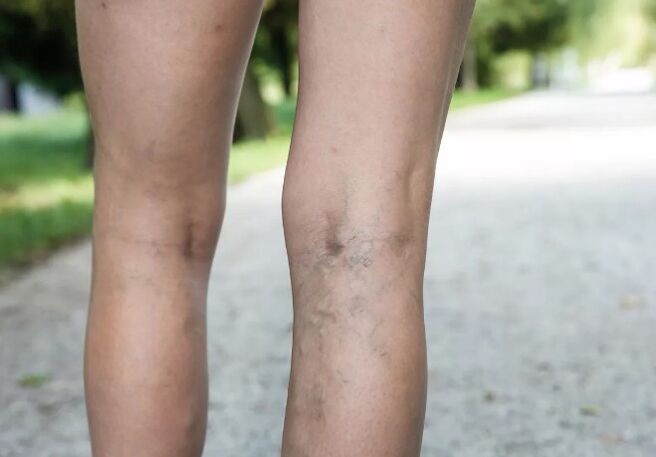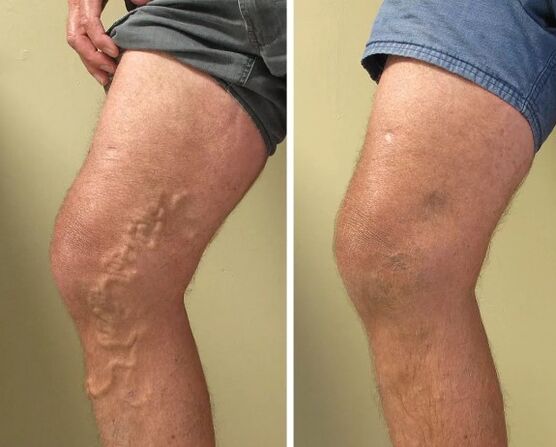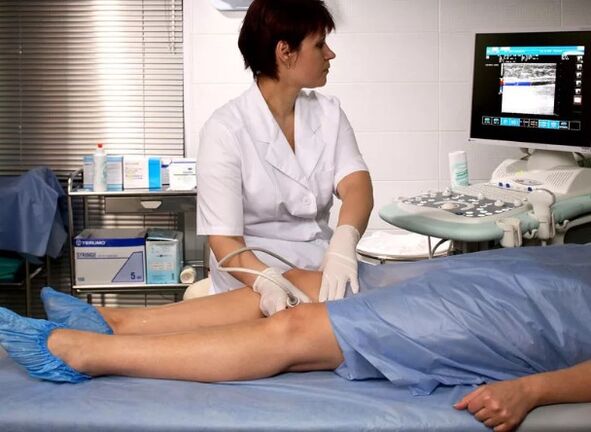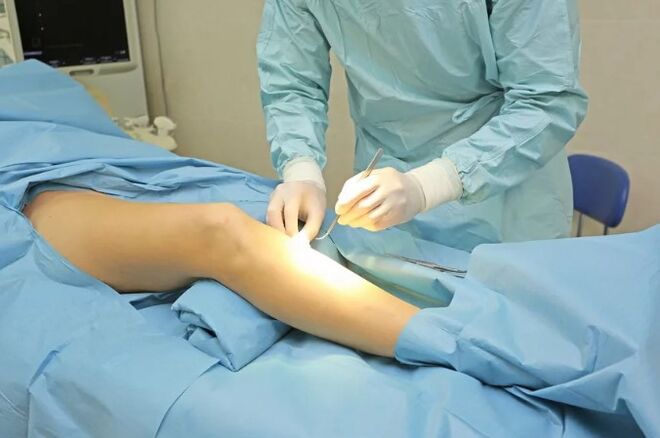Varicose veins in the foot are a specific expansion of the lower extremities veins, which is associated with a general violation of blood flow and valve failure. The expansion of veins is characteristic of women and men aged 40 to 60 years.

Development mechanism
Promoting the development of a pathology such as varicose veins is considered to be a violation of the normal functioning of the venous valves with the appearance of blood reflux (reflux - reverse current). At the cellular level, this is associated with a violation of balance between some components of the venous wall.
The initial stage is characterized by the presence of a genetic and causal factor (prolonged stay in a sitting position, excess weight, damage, etc. ). At the same time, the so -called parameter of shear stress changes, which is a group of indicators of blood movement through vessels, in which the endothelium reacts very significantly.
If the irritating factor operates for a long time on the vessel wall, then the leukocytes are firmly fixed to the endothelial cells, which cause the initial stage of inflammation. The inflammatory process spreads through the venous canal of the lower extremities.
Especially quickly, such processes occur in valves, which are subject to constant, severe mechanical stress. However, inflammation in one leg may be more pronounced than in the other. First of all, it depends on the initial cause of organ damage, for example, from the right foot, varicose veins may be more pronounced among athletes that are emphasis on it.
With valve damage, a pathological blood flow occurs through the mouth of a large and small subcutaneous veins. Due to the rekindle, an excessive blood flow occurs, the wall of the venous vessels occurs.
Over time, the dynamic venous hypertension develops, which is characterized by a decrease in vessel pressure, as a rule, this occurs while walking, at the level of inability to provide normal blood perfusion through the tissues.
Such a process is associated with edema, impregnation of subcutaneous tissue with blood cells (red blood cells and leukocytes). Over time, the skin changes its color, swell, skin pigmentation has improved. With cell death, which is not improper during medical care, which further leads to the development of trophic ulcers.

Classification of varicose veins
By 2000, a new classification of varicose veins of the lower extremities was developed.
Varicose vein forms:
The degree of chronic venous insufficiency:
Complications of venous enlargement of the lower limb veins are one of the serious conditions affecting the body: thrombophlebitis, trophic ulcers, erysipelas, erysipelas or bleeding.
Classification of the work of the disease
By form:
From clinical groups:
Classification of work by complications and the degree of chronic failure does not differ from the standard.
Reasons for developing varicose veins
The exact reason for the development of this pathology has not yet been fully clarified, but there are a number of factors that contribute to the emergence of varicose veins:

The phases of the vein with varicose
For this period of development of medicine, there are three main stages of the development of varicose veins and early phases, when the disease is very difficult to observe.
The early stage of the disease is associated with swelling, weight, very often ill complain that the feet are injured during a long walk. These are all signs of the onset of pathology, it's time to start prevention - massage, walking creams, physical activity.
Expansion of 1st degree veins.This phase is characterized by all the symptoms listed above, to which vascular stars, bruising, knot veins, visible through the skin, are added. In addition, the appearance of convulsions at night and burning in the stop area is marked.
Expansion of the 2nd degree veins.At this stage, the total number of stars and joints increases, they become more noticeable. Swelling appears, leg pain increases and it becomes unbearable to endure it.
Expanding the 3rd degree veins.This is the most difficult phase, which is associated with serious leg lesions, becomes dry, inanimate and cracked. The skin of the lower leg becomes dark blue, its structure and pigmentation are changing.
The third stage is the last when this pathological process can be called varicose veins. Subsequent development of processes ceases to more serious illnesses.
It is advisable to consult a doctor in the second phase of the development of the disease, as in time, medical care is not given in serious consequences.
The question arises immediately, "which doctor will it go? ", The answer is simply - a doctor who specializes in the pathology of the lower extremities is called a phlebologist.

Symptoms and veins with varicose clinic
The main signs of this disease are numerous extension of subcutaneous veins, which is why it is called the disease. The onset of the disease is usually associated with some traits and non -specific.
In this condition, patients feel severity in the legs, rapid fatigue during movement, sometimes burning and abdominal pain. In addition to pain, the disease is manifested by edema that develops in the late afternoon, after a difficult day of work.
With a long varicose veins, symptoms such as eczema and itching appear. Patients scratch their legs, creating unpleasant sensations. Due to the development of the disease, the skin on the veins becomes thinner, itchy places are constantly brushed, which leads to the appearance of wounds.
Over time, the color of the skin on the lower leg becomes bluish. If medical care is not provided in such a situation, the development of skin hyperpigmentation and lipodermasclerosis is possible. In even more advanced stages, trophic ulcers develop.
Diagnosis of the disease
Different veins are visible and are not armed with an armed appearance, however, how dangerous this condition should be detected using instrumental diagnostic methods.
Currently, the most informative method is the ultrasound methodology of duplex scanning of veins. With its help, it is appreciated by the functioning of the valves, the cross ability and the presence of blood clots. Timely study of veins will avoid severe and irreversible consequences.
Treatment methods
How to treat varicose veins? Small veins of varicose cure are only possible with the help of surgical intervention. People who have an inherited predisposition or risk factors recommend visiting a specialized physician 2-3 times a year, for ultrasound vein examination, surgery from varicose veins is prescribed in the second stage of disease development.
How much does the operation cost? Mimi can be performed differently, it all depends on the severity of the development of the disease.

Surgical treatment
Flexolectomy
Indications for vein removal: varicose veins, pathological expansion of subcutaneous veins, trophic ulcers, acute thrombophlebitis, expansion of deep veins associated with general mistreatment (fatigue, dizziness).
Contraindications to the disease: coronary heart disease, pregnancy, elderly age, severe infectious diseases, inflammatory processes.
The advantage of surgical treatment is that this is the only effective method of treatment in advanced forms of the disease.
The disadvantage of this treatment: trauma, anesthesia, a long period after surgery.
Laser therapy (EVVK)
Indications: Varicose veins in the foot in combination with various serious diseases (ischemia, thrombophlebitis, asthma, bronchitis, pleurisy, ulcer, cholecystitis, pyelonephritis, peritonitis, dermatitis and boils).
Laser treatment is contraindicated in cases where it is observed: oncology, liver disease, kidneys, heart (decompensation phase), pregnancy and cerebral sclerosis.
The advantages of such treatment are to get rid of the vascular pattern, the maximum rapid, painless and safe procedure, requires no stationary and attraumatic observation.
Disadvantages: It is not available at all, expensive, wound appearance or clarification of the surrounding fabric is possible.
Coagulation of varicose vein radio frequency
Indications: Varicose veins with damage to the luggage of a small and large subcutaneous vein, trophic ulcers.
Contraindications: Acute form of thrombophlebitis, mental disorders, pregnancy.
Advantages: Without pain, hospitalization is not required after surgery, does not interfere with work.
Disadvantages: Expensive procedure.
Sclerotherapy
Indications: Varicose veins in the early stages.
Contraindications: Pregnancy, breastfeeding, allergic reaction to sclerosant, purulent-inflammatory processes of the feet, thrombosis.
The advantages of this method of treatment are that such financial treatment is cheaper than surgery, rapid healing, best cosmetic effect.
Disadvantages: Perhaps, the entry into the deep veins of the sclerosant is not sufficient effective with the advanced forms of the disease.
Treatment
Treatment of medication helps improve blood vessels, valve condition, increase blood flow and lymph, and also eliminates inflammation but does not heal the patient.
How to handle?

All the necessary products from varicose veins are divided into:
Home treatment
Traditional medicine provides for the use of ointments, lotions, tinctures, legs or different decoctions.
Varicose veins of apple cider vinegar treatment. It is impossible to cure such a disease with popular recipes, however, to relieve quite true symptoms, especially in the initial stage of development. For this, apple cider vinegar is used for coils, wiping, oral administration or for compresses.
How to avoid the disease?
A sedentary lifestyle, leg work, pregnancy is a greater load, as a result of which a disease such as varicose veins develops.
Varicosis in women is the same problem with cellulite, so special creams, lotions, compression socks and lymphatic drainage developed to fight it.
According to statistics, varicose veins in men are extremely rare, and even if it develops much slower.
Can I play sport?
Varicosis and jogging are two factors always walking nearby. The most effective prevention of expanding the veins of any of the stages is constant physical exercise: jogging, gymnastics, various exercises of strength, bike, etc.
There are a number of simple exercises to improve blood flow and prevent varicose veins:























